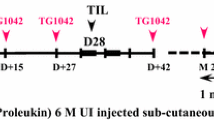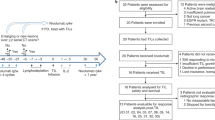Abstract
Tumor-infiltrating lymphocytes (TIL) from a wide range of human and murine tumors can be expanded in vitro using interleukin-2 (IL-2). These TIL are cytolytic T lymphocytes with in vivo and in vitro antitumor activity in mice and in humans. TIL from human melanoma can recognize autologous tumor in an MHC-restricted fashion, localize in vivo after111In labeling, and mediate regression of large metastatic deposits. Although studied extensively in vitro, less is known in vivo about TIL activity associated with tumor regression. This study was undertaken, in association with a study of TIL localization, to investigate mechanisms of TIL action by evaluating histopathological changes that occur at the tumor site during TIL administration. A total of 106 pre- and post-treatment pathological specimens from 25 patients enrolled in phase II TIL treatment and111In-TIL imaging protocols were examined blindly by a single pathologist. Histological subtype, lymphocytic infiltration, melanin content, vascularity, and necrosis were documented for each tumor specimen. Average baseline and post-treatment parameters were compared. Any significant changes were evaluated for correlation with clinical response and111In-TIL localization to tumor. Melanin content and vascularity of the tumor did not change as a result of therapy or correlate with either response or TIL localization. However, both increased lymphocytic infiltration and tumor necrosis were present after TIL administration (P=0.044 and 0.032 respectively). Furthermore, increases in lymphocytic infiltration correlated with tumor imaging using111In-TIL, and with the percentage of111In-labeled injectate present per gram of tumor specimen (P=0.036 and 0.0041 respectively). This suggests that TIL either account for the increased lymphocytes directly, or localize to tumor and recruit endogenous lymphocytes. We were unable to demonstrate any pretreatment histopathological predictors of response or variables that significantly correlated with subsequent clinical response, although peak and average values of necrosis were higher in responding patients compared to non-responding patients.
Similar content being viewed by others
References
Spiess PJ, Yang JC, Rosenberg SA (1987) In vivo antitumor activity of tumor infiltrating lymphocytes expanded in recombinant interleukin-2. J Natl Cancer Inst 79: 1067–1075
Rosenberg SA, Speiss P, Lafreniere R (1986) A new approach to the adoptive immunotherapy of cancer with tumor infiltrating lymphocytes. Science 233: 1318–1321
Yang JC, Perry-Lalley D, Rosenberg SA (1990) An improved method for growing murine tumor infiltrating lymphocytes with in vivo anti-tumor activity. J Biol Response Mod 9: 149–159
Topalian SL, Muul LM, Solomon D, Rosenberg SA (1987) Expansion of human infiltrating lymphocytes for use in immunotherapy trials. J Immunol Methods 102: 127–141
Muul LM, Spiess P, Director EP, Rosenberg SA (1987) Identification of specific cytolytic immune responses against autologous tumor in humans bearing malignant melanoma. J Immunol 138: 989–995
Topalian SL, Soloman D, Rosenberg SA (1989) Tumor specific cytolysis by lymphocytes infiltrating human melanomas. J Immunol 142: 3714–3725
Itoh K, Tilden AB, Balch CM (1986) Interleukin-2 activation of cytotoxic T-lymphocytes infiltrating into human metastatic melanomas. Cancer Res 46: 3211–3217
Schwartzentruber DJ, Topalian SL, Mancini M, Rosenberg SA (1991) Specific release of granulocyte-macrophage colony-stimulating factor, tumor necrosis factor-alpha, and interferongamma by human tumor infiltrating lymphocytes after autologous tumor stimulation. J Immunol 146: 3674–3681
Rosenberg SA, Packard BS, Aebersold PM, Soloman D, Topalian SL, Toy ST, Simon P, Lotze MT, Yang JC, Seipp CA, Simpson C, Carter C, Bock S, Schwartzentruber DJ, Wei JP, White DE (1988) Special report. Use of tumor infiltrating lymphocytes and interleukin-2 in the immunotherapy of patients with metastatic melanoma. A preliminary report. N Engl J Med 319: 1676–1680
Rosenberg SA, Lotze MT, Yang JC, Aebersold PM, Linehan WM, Seipp CA, White DE (1989) Experience with use of high dose interleukin-2 in the treatment of 652 cancer patients. Ann Surg 210: 474–483
Fisher B, Packard BS, Read EJ, Carrasquillo JA, Carter CA, Topalian SL, Yang JC, Yolles P, Larson SM, Rosenberg SA (1989) Tumor localization of adoptively transferred indium-111 labelled tumor infiltrating lymphocytes and peripheral blood lymphocytes in patients with metastatic melanoma. J Natl Cancer Inst 81: 1709–1717
Pockaj BA, Sherry R, Wei J, Yannelli JR, Carter CA, Leitman S, Carrasquillo J, White D, Steinberg SM, Rosenberg SA, Yang JC (1994) Localization of111indium-labelled tumor infiltrating lymphocytes to tumor in patients receiving adoptive immunotherapy: augmentation with cyclophosphamide and correlation with response. Cancer (in press)
Ames IH, Gagne GM, Garcia AM, John PA, Scatorchia GM, Tomar RH, McAfee JG (1989) Preferential homing of tumor-infiltrating lymphocytes in tumor-bearing mice. Cancer Immunol Immunother 29: 92–100
Swift RI, Danpure HJ, Osman S, Gaer J, Tsikos C, Peters AM, Lavender JP, Tebbut S, Habib NA, Wood CB (1991) Imaging of metastatic colorectal cancer with tumor-activated killer lymphocytes. Lancet 337: 1511–1512
Griffith KD, Read EJ, Carasquillo JA, Carter CS, Yang JC, Fischer B, Abershold P, Packard BS, Yu MY, Rosenber SA (1989) In vivo distribution of adoptively transferred indium-111 labelled tumor infiltrating lymphocytes and peripheral blood lymphocytes in patients with metastatic melanoma. J Natl Cancer Inst 81: 1709–1717
Basse P, Herberman RB, Nannmark U, Johansson BR, Hokland M, Wasserman K, Goldfarb RH (1991) Accumulation of adoptively transferred adherent, lymphokine-activated killer cells in murine metastases. J Exp Med 174: 479–488
Cohen PJ, Lotze MT, Roberts JR, Rosenberg SA, Jaffe ES (1987) The immunopathology of sequential tumor biopsies in patients treated with interleukin-2. Correlation of response with T-cell infiltration and HLA-DR expression. Am J Pathol 29: 208–216
Rubin JT, Elwood LJ, Rosenberg SA, Lotze MT (1989) Immunohistochemical correlation of response to recombinant IL-2 based immunotherapy in humans. Cancer Res 49: 7086–7091
Wallace PK, Palmer LD, Perry-Lalley D, Bolton ES, Alexander RB, Horan PK, Yang JC, Muirhead KA (1993) Mechanisms of adoptive immunotherapy: improved methods for in vivo tracking of tumor-infiltrating lymphocytes and lymphokine-activated killer cells. Cancer Res 53: 2358–2367
Aebersold P, Hyatt C, Johnson S, Hines K, Korkak L, Sanders M, Lotze M, Topalian S, Yang J, Rosenberg SA (1991) Lysis of autologous melanoma cells by tumor-infiltrating lymphocytes: association with clinical response. J Natl Cancer Inst 83: 932–937
Brichard V, Van Pel A, Wolfel T, Wolfel C, De Plain E, Lethe B, Coulie P, Boon T (1993) The tyrosinase gene codes for an antigen recognized by autologous cytolytic T-lymphocytes on HLA-A2 melanomas. J Exp Med 178: 489–495
Fox SB, Gatter KC, Bicknell R, Going JJ, Stanton P, Cooke TG, Harris AL (1993) Relationship of endothelial cell proliferation to tumor vascularity in human breast cancer. Cancer Res 53: 4161–4163
Hobson B, Denecamp J (1988) Endothelial proliferation in tumors and normal tissues: continuous labelling studies. Br J Cancer 46: 2938–2941
Pandolfi F, Trentin L, Lenora A, Boyle BA, Stamenkovic I, Byers R, Colvin RB, Kurnick JT (1992) Expression of cell adhesion molecules in human melanoma cell lines and their role in cytotoxicity mediated by tumor-infiltrating lymphocytes. Cancer 69: 1165–1173
Author information
Authors and Affiliations
Rights and permissions
About this article
Cite this article
Cole, D.J., Taubenberger, J.K., Pockaj, B.A. et al. Histopathological analysis of metastatic melanoma deposits in patients receiving adoptive immunotherapy with tumor-infiltrating lymphocytes. Cancer Immunol Immunother 38, 299–303 (1994). https://doi.org/10.1007/BF01525507
Received:
Accepted:
Issue Date:
DOI: https://doi.org/10.1007/BF01525507




